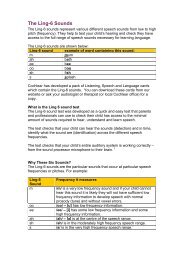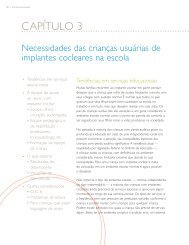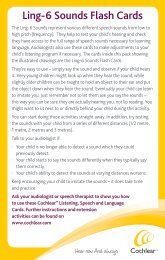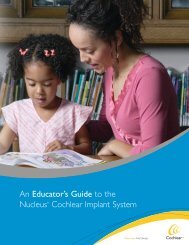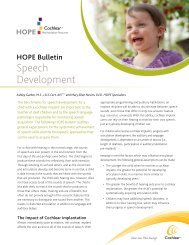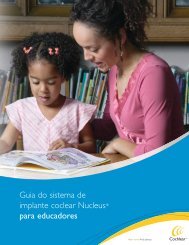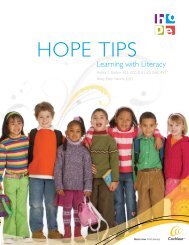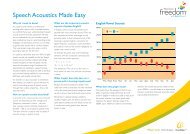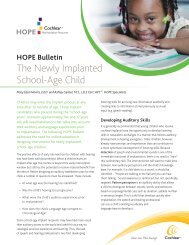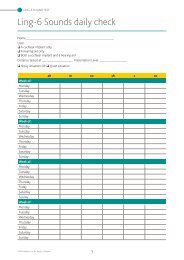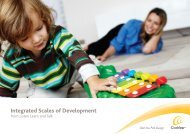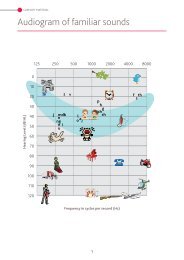Download HOPE note auditory skill development - Cochlear
Download HOPE note auditory skill development - Cochlear
Download HOPE note auditory skill development - Cochlear
You also want an ePaper? Increase the reach of your titles
YUMPU automatically turns print PDFs into web optimized ePapers that Google loves.
<strong>HOPE</strong> Bulletin<br />
Auditory Skill<br />
Development<br />
Mary Ellen Nevins, Ed.D. and Ashley Garber, M.S., LSLS Cert. AVT ® <strong>HOPE</strong> Specialists<br />
Auditory performance with a cochlear implant can<br />
be described using four broad categories of <strong>auditory</strong><br />
<strong>skill</strong>. In younger children, <strong>development</strong> of <strong>auditory</strong><br />
<strong>skill</strong>s occurs in a more naturalistic fashion in which<br />
all <strong>skill</strong>s are targeted simultaneously. For older<br />
children <strong>development</strong> of <strong>auditory</strong> <strong>skill</strong>s may be more<br />
linear and systematic. The following <strong>HOPE</strong> Bulletin<br />
provides information on the hierarchy of <strong>auditory</strong> <strong>skill</strong><br />
<strong>development</strong> that is essential for assessing current<br />
ability, targeting intervention goals and providing<br />
habilitation to children with cochlear implants.<br />
A number of researchers and interventionists have proposed<br />
models of <strong>auditory</strong> <strong>skill</strong> <strong>development</strong>. While there may be<br />
some differences between and among models, it may be<br />
sufficient to consider five major stages of <strong>auditory</strong> <strong>skill</strong>s<br />
<strong>development</strong> for children who use implants.<br />
• Detecting or hearing a sound without knowing what<br />
made the sound or what it means. This is generally the<br />
first listening behavior observed after implantation.<br />
• Patterning or differentiating between sounds based on<br />
the patterns of those sounds. For example, a child may<br />
be able to tell the difference between sounds that are<br />
long versus those that are short or a one-syllable word<br />
versus a polysyllabic word.<br />
• Discriminating or determining if two <strong>auditory</strong> stimuli<br />
are the same or different. This <strong>auditory</strong> <strong>skill</strong> is not one<br />
specifically designated for instruction, rather it is used<br />
as a tool to compare and contrast listening targets.<br />
• Identifying or repeating what has been heard or selecting<br />
a word from a group of choices. This listening <strong>skill</strong> is<br />
supported by a good vocabulary and language base.<br />
• Comprehending or processing spoken language and<br />
responding to it appropriately. For example, a child<br />
who answers a question through listening alone is<br />
demonstrating <strong>auditory</strong> comprehension.<br />
Acquiring Auditory Skills<br />
One may view the <strong>development</strong> of <strong>auditory</strong> <strong>skill</strong> from either<br />
of two perspectives: a top down, wholistic perspective or a<br />
bottom-up, building block perspective.<br />
Top-Down Approach: Considered the more naturalistic of<br />
the two perspectives, listening <strong>skill</strong>s are both the process and<br />
the product of easy communication between young child and<br />
caregiver. Auditory access provided by the cochlear implant<br />
gives young, severely to profoundly deaf children the greatest<br />
potential to develop <strong>auditory</strong> <strong>skill</strong>s in a naturalistic,<br />
but facilitated manner.
This most parallels <strong>skill</strong> <strong>development</strong> in hearing children<br />
in which <strong>auditory</strong> <strong>skill</strong>s (and the language <strong>development</strong> that<br />
follows from their acquisition) are facilitated but not<br />
specifically taught. Input by the adult caregiver or speech<br />
and hearing professional is abundant and purposeful; the<br />
child absorbs language through listening as part of overall<br />
cognitive <strong>development</strong>.<br />
Bottom-Up Approach: Children who are somewhat older<br />
and/or who have learning challenges in addition to deafness<br />
may benefit from more directed listening experiences in<br />
which specific <strong>auditory</strong> <strong>skill</strong>s are introduced and practiced<br />
until mastered. This is no less a path to <strong>auditory</strong> comprehension,<br />
but it generally requires more detailed planning and systematic<br />
presentation to the child. The rate at which a child develops<br />
<strong>auditory</strong> <strong>skill</strong>s will depend on a number of factors, some of which<br />
are within the control of the school-based professional while<br />
others are not. Some children benefit from a period of directed<br />
listening early on in the process and transition to more natural<br />
<strong>skill</strong> <strong>development</strong> once <strong>auditory</strong> access has been “jump started.”<br />
Language and Listening<br />
There is a complex relationship between listening and language<br />
such that advanced <strong>auditory</strong> <strong>skill</strong>s may be observed in the<br />
context of simplistic language, and complex language forms<br />
will dictate a return to previously acquired <strong>auditory</strong> <strong>skill</strong>s.<br />
In some circumstances, the <strong>development</strong> of <strong>auditory</strong> <strong>skill</strong>s<br />
is hampered by limitations in vocabulary and incomplete<br />
language learning that occurred prior to implantation. When<br />
this is the case, as in older children receiving implants, it<br />
is incumbent upon the speech and hearing professional<br />
to monitor absolute <strong>auditory</strong> <strong>skill</strong> <strong>development</strong> (using<br />
assessments that take a child’s language ability into account)<br />
in order to determine <strong>auditory</strong> progress with the device.<br />
Regardless, the interventionist will work toward moving<br />
<strong>auditory</strong> <strong>skill</strong>s along a continuum with the ultimate goal of<br />
having audition contribute to subsequent language learning.<br />
Related Resources<br />
Caleffe-Schenck, N. (2006). An Auditory Approach: Focus<br />
on Children with Bilateral <strong>Cochlear</strong> Implants. <strong>HOPE</strong> Online<br />
Library. Available at www.<strong>Cochlear</strong>Americas.com/<strong>HOPE</strong><br />
Chute, P., & Nevins, M.E. (2006). Developing Auditory Skills:<br />
Thinking Outside the Box in School Professionals Working with<br />
Children with <strong>Cochlear</strong> Implants. San Diego: Plural Publications.<br />
Erber, N. (1982). Auditory Training, Washington D.C.:<br />
AG Bell Publications.<br />
McClatchie, A., & Therres, M.K. (2003). Auditory in AuSpLan:<br />
Auditory, Speech and Language: A Manual for Professionals<br />
Working with Children Who Have <strong>Cochlear</strong> Implants or<br />
Amplification. Available from Children's Hospital and<br />
Research Center at Oakland, CA, 510.428.3344.<br />
Moog, J., Biedenstien, J., & Davidson, L. (1995). Speech<br />
Perception Instructional Curriculum and Evaluation (SPICE).<br />
St. Louis, MO: Central Institute for the Deaf.<br />
Nevins, M.E., & Garber, A.S. (2005). Getting Started with<br />
Auditory Skills. <strong>HOPE</strong> Online Library. Available at<br />
www.<strong>Cochlear</strong>Americas.com/<strong>HOPE</strong><br />
Nevins, M.E., & Garber, A.S. (2005). CLIC-IT! Creating Listeners<br />
in the Classroom - Ideas for Teaching. <strong>HOPE</strong> Online Library.<br />
Available at www.<strong>Cochlear</strong>Americas.com/<strong>HOPE</strong><br />
Pollack, D., Goldberg, D., & Caleffe-Schenck, N. (1997).<br />
Educational Audiology for the Limited Hearing Infant and<br />
Preschooler: An Auditory-Verbal Program. Springfield, IL:<br />
Charles C. Thomas.<br />
<strong>Cochlear</strong> and the elliptical logo are trademarks of <strong>Cochlear</strong> Limited.<br />
FUN666 ISS5 DEC10<br />
<strong>Cochlear</strong> Americas<br />
13059 East Peakview Avenue<br />
Centennial, CO 80111<br />
1 800 523 5798<br />
www.<strong>Cochlear</strong>Americas.com/<strong>HOPE</strong>




